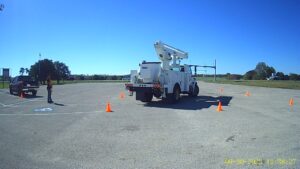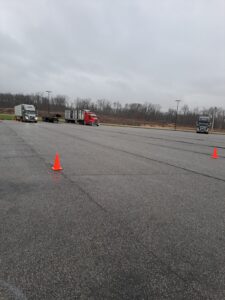 Behind-the-Wheel Training Requirements
Behind-the-Wheel Training Requirements
The driver must demonstrate his/her ability to control the cmv in all the following exercises:
- Straight line backing
- Offset back/right
- Offset back/left
- Parallel Park (drivers’ side)

- Parallel Park (passenger side)
- Alley dock (trailer)
The driver will be tested on his/her ability to safely complete
- Turn the vehicle
- Traverse intersections
- Maintain proper lane positioning and lane use
- Change lanes
- Enter/Exit interstate highway systems
- Stop/Start VID_166 Pre-Trip Inspection
- Enter/Exit curved portion of roadway
- Cross railroad tracks
- Observe and identify bridge/overpass signage indicating clearance height
- Proper use of acceleration and braking (clutch if equipped)
- Proper steering
- Attention to traffic and use of mirrors
- Proper use of turn signals
The following are specific areas that the instructor will address during training:
- Failure to come to a complete stop
- Following too closely
- Speeding (immediate failure if speeding during training)
- Fail to signal for turn or lane change movement
- Hard braking event
- Incorrect or improper lane use
- Improper stop or incorrect position at the time of stop at an intersection
- Speed too slow for traffic conditions or roadway
- Improper turn
The following will be immediate failure during skills test training:
- Driver commits an extremely unsafe action
- Driver commits a series of unsafe actions
- Driver lacks the ability to safely operate the cmv
- Driver is involved in a collision
- Driver fails to follow the directions and practices taught by the instructor
During the on-road section of the Behind-the-Wheel Training Skills Test, the driver will experience the following:
- Traffic lights and stop signs
- Lane changes
- Turning movements at major intersections
- Railroad grade crossing
- School zone
- Right turns
- Left turns
- Merging into and out of traffic
- Being able to read and recall signage while driving
- Safe and properly park
Start Now

